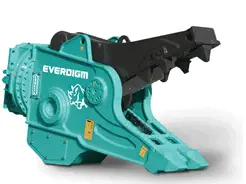Excavator hammer attachments are essential tools in modern construction, helping to break through tough materials and boost project efficiency. However, their performance does not depend only on the equipment. Evaluating impact energy is important for achieving the best results.
Construction companies can check the impact energy of hammer attachments. This helps them boost performance, cut costs, and improve efficiency on the job site.
In this article, we will explain why impact energy assessments are important for excavator hammer attachments. We will also show how proper evaluation can greatly improve construction projects.
Let’s get started!
Understanding Impact Energy in Hammer Attachments
Impact energy is a crucial metric that measures the force an excavator hammer attachment exerts during operation. Expressed in joules, it indicates how much energy is transferred from the hammer to the material being broken down.
The higher the impact energy, the more powerful the blow, enabling the hammer to penetrate tough materials more effectively.
However, it’s not just about sheer force. Efficient energy transfer is important. It helps apply energy correctly and prevents unnecessary strain on the equipment. By accurately assessing impact energy, operators can guarantee that their hammer attachments perform at their best, ensuring smooth and effective material handling for construction and demolition projects.
Why Assessing Impact Energy Matters
Performance Optimisation
Excavator hammer attachments are designed to break tough materials like concrete and rock. If the hammer provides too little impact energy, it can slow down the project because it takes longer to break down materials.
On the other hand, too much impact energy can harm the excavator and cause extra wear and tear. Regular assessments of impact energy help operators find the right balance between power and efficiency.
By knowing the right amount of impact energy needed for different materials, construction companies can boost performance, extend the life of their equipment, and prevent overworking their machines.
Improved Efficiency
Efficiency is critical on any construction site, as time lost to delays or setbacks can drive up project costs. Impact energy assessments help operators ensure their hammer attachments are providing the right amount of power to get the job done quickly and effectively.
If an attachment has too little impact energy, it will take multiple blows to break through tough materials, wasting time and fuel. On the other hand, if it delivers too much force, it may over-penetrate, wasting energy and causing extra wear on the equipment.
By properly assessing the needed impact energy, construction teams can find the ideal balance between speed and effectiveness.
Reduced Wear & Tear
Applying too much impact energy to an excavator hammer attachment can lead to premature wear and tear on both the attachment and the machine. This increases the risk of equipment failure and leads to higher maintenance and repair costs.
Regular impact energy assessments help operators avoid pushing hydraulic hammer attachments beyond their limits. By staying within the recommended energy levels, companies can reduce the chance of damage, extend the life of their attachments, and cut down on costly maintenance downtime.
Cost Savings
Hammer attachments are a big investment for construction companies, so it’s important to maximise their use. Impact energy assessments can help save costs in several ways.
First, by optimising performance, companies can finish projects faster, reducing labour and operations costs. Second, assessing impact energy helps prevent equipment failures, which can lead to costly repairs or replacements.
Finally, greater efficiency on the job site means lower fuel consumption and less wear on other machinery parts, further lowering operation expenses.
Safety Improvements
Safety is very important on construction sites. Assessing impact energy helps keep the work environment safe. If hammer attachments are too powerful or not powerful enough, it can lead to accidents, whether from the machine not working correctly or operators having to use too much force.
By regularly checking impact energy and adjusting, operators can ensure their equipment runs safely and effectively. This reduces the chances of accidents caused by misuse or faulty machinery.
Conclusion: A Smarter Approach to Hammer Attachments
In construction, where efficiency and performance are essential, assessing impact energy for excavator hammer attachments is crucial. By regularly checking this energy, construction companies can improve performance, decrease wear and tear, and lower operations costs, all while keeping the work environment safe.
As the industry evolves, using technology like telematics will make it even easier to monitor and assess impact energy in real time.
In the end, a well-kept hammer attachment with good impact energy is important for any construction company. By valuing regular assessments, businesses can boost efficiency, minimise costs, and keep their operations running smoothly.

